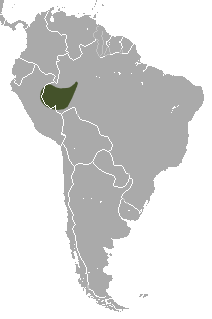| McIlhenny's four-eyed opossum | |
|---|---|
| Scientific classification | |
| Kingdom: | Animalia |
| Phylum: | Chordata |
| Class: | Mammalia |
| Infraclass: | Marsupialia |
| Order: | Didelphimorphia |
| Family: | Didelphidae |
| Genus: | Philander |
| Species: | P. mcilhennyi |
| Binomial name | |
| Philander mcilhennyi Gardner & Patton, 1972 | |
 | |
| McIlhenny's four-eyed opossum range | |
McIlhenny's four-eyed opossum (Philander mcilhennyi) is a South American species of opossum. [2] Found in Brazil and Peru, it is almost entirely black, except for white spots above each eye.
This species is named for John Stauffer "Jack" McIlhenny (1909-1997), a grandson of the founder of the McIlhenny Company, maker of Tabasco sauce. He funded the 1968 Louisiana State University expedition that discovered the species.
